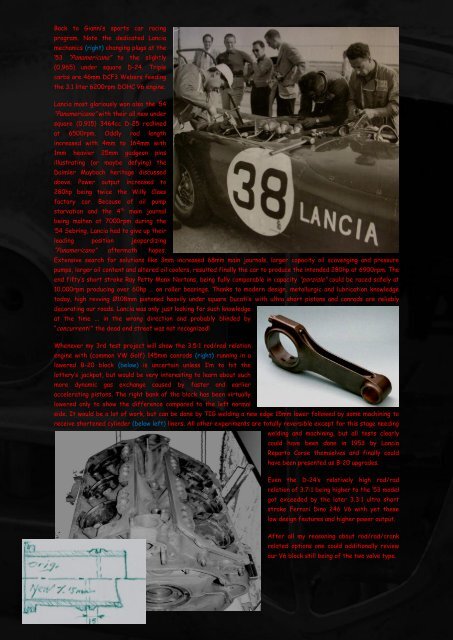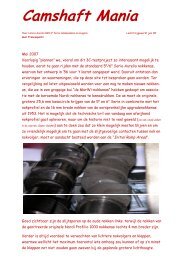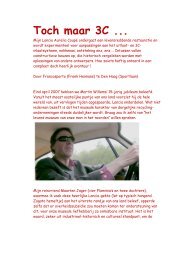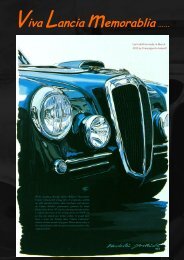Create successful ePaper yourself
Turn your PDF publications into a flip-book with our unique Google optimized e-Paper software.
Back to Gianni‟s sports car racing<br />
program. Note the dedicated Lancia<br />
mechanics (right) changing plugs at the<br />
‟53 “Panamericana” to the slightly<br />
(0,965) under square D-24. Triple<br />
carbs are 46mm DCF3 Webers feeding<br />
the 3.1 liter 6200rpm DOHC <strong>V6</strong> engine.<br />
Lancia most gloriously won also the ‟54<br />
“Panamericana” with their all new under<br />
square (0,915) 3464cc D-25 redlined<br />
at 6500rpm. Oddly rod length<br />
increased with 4mm to 164mm with<br />
1mm heavier 25mm gudgeon pins<br />
illustrating (or maybe defying) the<br />
Daimler Maybach heritage discussed<br />
above. Power output increased to<br />
280hp being twice the Willy Claes<br />
factory car. Because of oil pump<br />
starvation and the 4 th main journal<br />
being molten at 7000rpm during the<br />
‟54 Sebring, Lancia had to give up their<br />
leading position jeopardizing<br />
“Panamericana” aftermath hopes.<br />
Extensive search for solutions like 3mm increased 68mm main journals, larger capacity oil scavenging and pressure<br />
pumps, larger oil content and altered oil coolers, resulted finally the car to produce the intended 280hp at 6900rpm. The<br />
end fifty‟s short stroke Ray Petty Manx Nortons, being fully comparable in capacity “parziale” could be raced safely at<br />
10.000rpm producing over 60hp … on roller bearings. Thanks to modern design, metallurgic and lubrication knowledge<br />
today, high revving Ø108mm pistoned heavily under square Ducati‟s with ultra short pistons and conrods are reliably<br />
decorating our roads. Lancia was only just looking for such knowledge<br />
at the time ... in the wrong direction and probably blinded by<br />
“concurrenti ” the dead end street was not recognized!<br />
Whenever my 3rd test project will show the 3.5:1 rod/rad relation<br />
engine with (common VW Golf) 145mm conrods (right) running in a<br />
lowered B-20 block (below) is uncertain unless I‟m to hit the<br />
lottery‟s jackpot, but would be very interesting to learn about such<br />
more dynamic gas exchange caused by faster and earlier<br />
accelerating pistons. The right bank of the block has been virtually<br />
lowered only to show the difference compared to the left normal<br />
side. It would be a lot of work, but can be done by TIG welding a new edge 15mm lower followed by some machining to<br />
receive shortened cylinder (below left) liners. All other experiments are totally reversible except for this stage needing<br />
welding and machining, but all tests clearly<br />
could have been done in 1953 by Lancia<br />
Reparto Corse themselves and finally could<br />
have been presented as B-20 upgrades.<br />
Even the D-24‟s relatively high rod/rad<br />
relation of 3.7:1 being higher to the ‟53 model<br />
got exceeded by the later 3.3:1 ultra short<br />
stroke Ferrari Dino 246 <strong>V6</strong> with yet these<br />
low design features and higher power output.<br />
After all my reasoning about rod/rad/crank<br />
related options one could additionally review<br />
our <strong>V6</strong> block still being of the two valve type.





